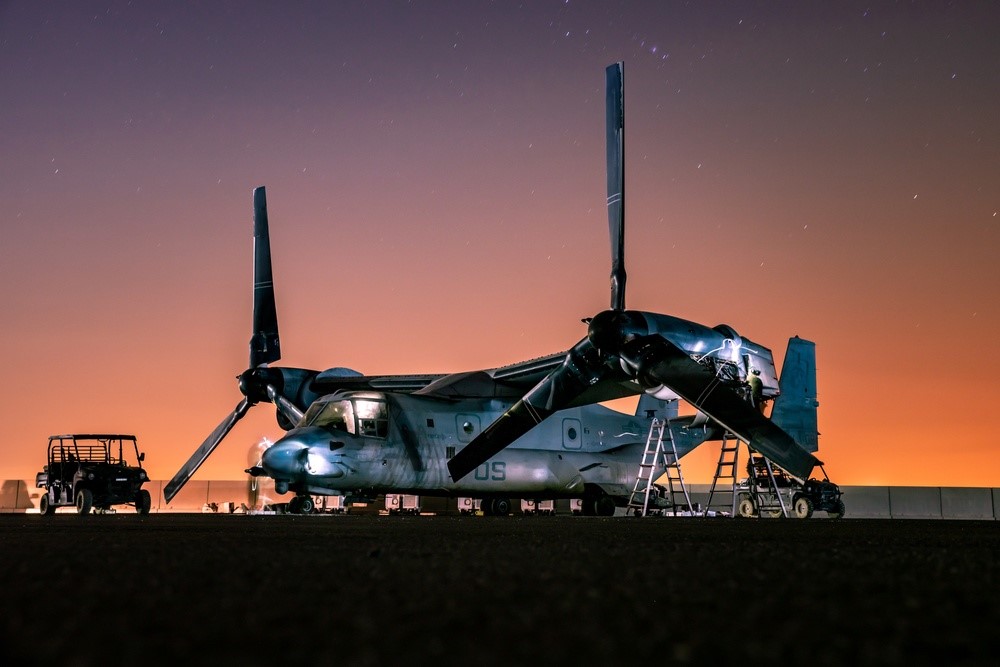
The Department of Defense’s (DOD) V-22 Osprey fleet remains grounded (save for one deployed Marine unit), having not flown since before the beginning of the new year. Each additional no-fly day increases the impact and consequences of sitting out a critical aircraft in Navy, Marine Corps, and Air Force squadrons. Pressure and focus on the Osprey continue to build from many angles. The Pentagon and industry’s ability to assess the issues, provide a sustainable solution, restore trust, and return the V-22 to flight quickly is crucial for military operations and forthcoming tiltrotor and vertical take-off and landing (VTOL) programs.
The most recent grounding of all U.S. military V-22s began on December 6th following the November 29th crash of an Air Force Special Operations Command (AFSOC) CV-22B conducting a training flight off Japan. Eight service members were lost in the accident. While details of the cause of the crash have not been released, the Air Force initially indicated the crash likely occurred due to a mechanical failure and not pilot or crew error.
Approximately 415 total Ospreys are down across the services. Japan, the only foreign operator of the V-22, also grounded its fleet of 17 aircraft. The U.S. Marine Corps flies the lion’s share, roughly 335 MV-22Bs, as an amphibious assault aircraft. Air Force CV-22s provide long-range insertion and extraction capabilities for special operations forces, and the Navy CMV-22B, which reached initial operating capability (IOC) in 2022, replaces the fixed-wing C-2A Greyhound for the carrier-onboard delivery (COD) mission.
Reputation, Hard to Build and Easy to Lose
The V-22 tiltrotor carries the perception of a dangerous aircraft due to a series of mishaps and groundings throughout its history. Over the Osprey’s lifetime, over 50 U.S. service members have been killed in crashes, 20 of which occurred in four different crashes in the past two years. In December, the U.S. House Committee on Oversight and Accountability opened an investigation into the Osprey program. In a letter to Defense Secretary Austin, the committee chairman emphasized concerns regarding the aircraft’s “safety and performance issues” and a history of crashes due to engine failure and faulty gearboxes.
An ongoing transmission issue–hard clutch engagement (HCE)–remains a flaw associated with several deadly V-22 crashes. The phenomenon occurs when the clutch, handling power between the engine and a prop rotor, slips and re-engages suddenly causing damage to the system and potentially leading to uncontrollability. While the DOD has prioritized clutch replacements on certain V-22 aircraft, the root cause of the issue is not entirely known or understood by the military or the Osprey’s manufacturers. A potential solution and cause at this time is only theoretical.
The issue presents a complex situation because of the unique capability the Osprey brings to the services and the distinctive mechanical issue plaguing the aircraft. Operationally, the Osprey’s tiltrotor design affords crews and strategic planners a platform that combines the best of fixed-wing and rotary-wing aircraft. That is the speed, range, and altitude of an airplane and the versatility, maneuverability, and convenience of a helicopter. However, the tiltrotor also brings inherent difficulties in broadly implementing a first-of-its-kind aircraft.
The negative attention on the Osprey, one publication called it a ‘death trap,’ may not be entirely warranted. The Air Force Safety Center reports the V-22 10-year average annual class A mishap rate is 0.50 per 100,000 flight hours, the same rate as the H-60 helicopter in that category. Though dated, a Marine Aviation spokesman wrote in 2022 that the MV-22 10-year average mishap rate was 3.16 per 100,000 flight hours. At the time, it had a lower mishap rate than Marine AV-8 Harriers, certain variants of the F/A-18, F-35Bs, and CH-53Es.
The Osprey’s history is not entirely distinct from other military rotorcraft. The Army grounded roughly 630 UH-60 helicopters in 1985, six years after the aircraft entered service, due to 37 deaths across 23 incidents. Today, the H-60 helicopter is, arguably, the DOD’s most successful and widely-employed rotary-wing platform. Military aviation is inherently dangerous and can result in tragedy as new technologies meet the operational environment.
And yet, even as this piece is published, recent disclosures from the Pentagon show the Navy’s CMV-22B aircraft was “not operationally suitable due to failures of my subsystems,” including the ice protection system leading to 44 percent of mission failures. The news comes nearly two years after the CMV-22B achieved IOC. The current fleet-wide groundings now mark 16 years, a long time, since the Air Force received the first Osprey.
Operational Impacts
The grounding and associated effects could not come at a worse time. The DOD is all-in financially and operationally with the V-22. Officials must act quickly and transparently to remedy a solution and restore trust in the Osprey between Congress, the military, and the public. Given the crucial importance of the aircraft to several service branches, an ongoing grounding of this magnitude is untenable.
Stand-in aircraft filling the Osprey’s vacancies cannot meet the full mission capabilities of the V-22. The Navy, which has called back up the C-2A, planned to shutter one of two remaining C-2 squadrons in December. The CMV-22B affords greater range than the C-2A due to its in-air refueling capability and is less disruptive on the aircraft carrier’s flight cycle because it lands like a helicopter. The CH-53E Sea Stallion, which the Marines are flying more heavily due to the grounding, cannot fly as high, fast, or far as the MV-22.
It is particularly concerning given the military situation in the Middle East. An MV-22 squadron presently deployed on the USS Bataan (LHD-5) received flight approval for emergency operations, which only highlights the Osprey’s indispensability to a deployed Amphibious Ready Group (ARG). The Pentagon has weighed extending the Bataan ARG’s deployment due to instability in the Red Sea.
The loss of such a crucial aircraft like the V-22 in a potential future conflict in the Pacific could alter the balance of power and severely impede U.S. combat operations. It is doubly true for the Osprey that can help offset the range and distance issues presented by the Pacific naval theater.
The Future of DOD VTOL
Also at risk is the success of future military tiltrotor programs. It is unknown whether any mechanical issues with the Osprey could present in the Bell V-280 tiltrotor, which will replace Army UH-60 Black Hawks beginning in 2030. The V-280 program will likely exceed the size of the MV-22 program as the Army could procure approximately 600 aircraft. The aircraft differ in some key design areas, including how the nacelles rotate; however, the Osprey groundings from an ongoing mechanical failure cast some doubt on the success of a second major tiltrotor initiative.
The problem could become even more acute as the Navy seeks a replacement for its Seahawk helicopter fleet in the next decade, which could include considering a marinized tiltrotor platform.
Meanwhile, the Osprey groundings, with no foreseeable end, remain a present-day problem. A Senior Marine official recently discussed the atrophying effect the groundings have on the skills of pilots and maintainers. The effect is certainly mutual with Navy and Air Force Osprey crews. As defense officials are well aware, so much relies on a timely and enduring solution. Military aircraft are not meant to sit in hangars while pilots fly simulators.
A former naval officer and helicopter pilot, Jon covers a range of Forecast International reports and products, drawing on his 10-year background in military aviation, operations, and education. His previous military assignments include multiple overseas deployments supporting operations in the Arabian Gulf, NATO exercises, and humanitarian missions. Jon’s work is also influenced by his time as a former Presidential Management Fellow and international trade specialist at the Department of Commerce.
Before joining Forecast International, Jon also served as an NROTC instructor and Adjunct Assistant Professor at the University of Texas, where he taught undergraduate courses on naval history, navigation, defense organization, and naval operations and warfare. A lifelong reader and learner, his academic and professional interests include aviation, political and military history, national defense and security, and foreign area studies.



